Have you ever heard of Rinpa? If you’re drawn to Japanese aesthetics—whether it’s traditional crafts, contemporary design, or nature-inspired beauty—Rinpa offers a fascinating window into Japan’s unique visual culture. Originating in the early 17th century, Rinpa is not just an art movement but a lineage of style, taste, and admiration passed down through generations.
What Is Rinpa?
Rinpa (琳派) is a school of Japanese art that emerged during the Momoyama period (late 16th to early 17th century) and flourished throughout the Edo period (17th–19th centuries). Unlike other major schools, such as Kano or Tosa, which were based on family dynasties or formal teacher-student relationships, Rinpa was formed through aesthetic admiration and homage to the works of previous artists. This informal lineage gave rise to a fluid, evolving visual tradition.
Origins of Rinpa
Rinpa traces its roots to two Kyoto-based creatives:
- Hon’ami Koetsu (1558–1637): a calligrapher, potter, and designer
- Tawaraya Sotatsu (early 1600s): a painter known for his bold compositions
Their collaborations—notably works that combined calligraphy and painting—laid the foundation for the Rinpa aesthetic. Sotatsu introduced techniques like gold and silver leaf backgrounds and expressive brushwork, creating dramatic visual contrasts.

The roots of Rinpa are generally traced back to two artists, Hon’ami Koetsu and Tawaraya Sotatsu. Sotatsu established the unique techniques and styles of Rinpa, such as using gold and silver foil for backgrounds and employing unique ink shading. Through collaborations with Koetsu, they created works that integrated calligraphy and painting, a legacy later completed by Ogata Korin, who admired Sotatsu. Incidentally, “Rinpa” was coined from the ‘Rin in Korin’s name.
A century later, Ogata Korin (1658–1716) revived and expanded upon these styles. Deeply inspired by Sotatsu, he refined the use of flat color planes, decorative motifs, and asymmetrical compositions. The term “Rinpa” comes from the “Rin” (琳) in Korin’s name, paired with “pa” (派), meaning “school” or “faction.”

Another hundred years on, Sakai Hoitsu (1761–1828) continued the Rinpa lineage by honoring Korin’s legacy—demonstrating how Rinpa evolved through “shishuku” (私淑), or private admiration, rather than formal mentorship.
Rinpa is less a genre and more a transgenerational lineage of sensibility, carried by artists who felt a deep resonance with the aesthetic ideals of their predecessors.

Key Characteristics of Rinpaa
What makes Rinpa visually distinctive is its design-minded approach and decorative elegance, breaking from more literal or narrative painting styles of its time.
Four Defining Features:
- Vivid Colors: Bold, vibrant pigments paired with refined gold and silver leaf.
- Nature-Inspired Motifs: Subjects often include flowers, birds, waves, and seasonal elements, rendered in stylized forms.
- Ornamentation: Highly decorative, with a balance between embellishment and structured beauty.
- Innovative Composition: Often features asymmetry, space, and rhythmic balance that feel surprisingly modern.
Rinpa’s Influence on Modern Japanese and Global Art
The Rinpa aesthetic didn’t fade with time—it expanded. Its influence can be seen in:
- Modern Japanese painting (Nihonga) of the Meiji and Taishō periods
- 20th-century modernism and postmodernism
- Contemporary design and craft, both in Japan and abroad
The 2004 exhibition Rinpa: The Aesthetics of the Capital at the National Museum of Modern Art, Tokyo, highlighted how Rinpa sensibilities echo in the works of Klimt, Matisse, and Andy Warhol, as well as in Japanese artists like Hishida Shunsō and Yokoyama Taikan.1
Rinpa’s decorative elegance and nature-centric worldview continue to resonate with contemporary artists and designers worldwide.
Rinpa in Contemporary Craft: The Kogei Art KYOTO Collection
At Kogei Art KYOTO, we celebrate how this centuries-old sensibility lives on in modern craft. Several works in our collection are either:
- Inspired by Rinpa motifs, such as seasonal flowers and gold-leaf patterns
- Or express a Rinpa spirit through their bold forms, stylized nature, and refined use of materials
These pieces are not replicas—they’re original artworks that translate the Rinpa lineage into contemporary expression, showing how tradition can evolve without losing its soul.

Final Thoughts
Rinpa is more than an art style—it’s a cultural legacy. Its ability to transcend time, inspire across disciplines, and adapt to new contexts makes it one of Japan’s most enduring contributions to global aesthetics.
Whether you’re a collector, a designer, or simply someone who appreciates the beauty of crafted objects, understanding Rinpa opens a new dimension in the appreciation of Japanese art.
References and Further Reading
- Stephen Addiss, Rinpa: Masterworks of the Japanese Decorative School. Tokyo: Kodansha International, 1980.
A foundational English-language book introducing the Rinpa school with detailed images and context. - Penelope Mason, History of Japanese Art. 2nd ed. Pearson Prentice Hall, 2005.
Offers a comprehensive overview of Japanese art history, including the evolution of Rinpa.Nihon Keizai Shimbun, Rinpa: The Aesthetics of the Capital – Edo Paintings from the Price Collection. Tokyo: Nikkei Inc., 2004.
The National Museum of Modern Art, Tokyo’s exhibition catalog, draws connections between Rinpa and Western modern art. - Tokyo National Museum – Rinpa: Beauty and Aesthetics in Japanese Art
Online exhibition page introducing Rinpa’s key figures and representative works (in English). - The Metropolitan Museum of Art – Rinpa Painting Style (17th–19th Century)
A concise and reliable introduction to Rinpa from one of the world’s leading art institutions. - Kogei Art KYOTO – Contemporary Expressions of Rinpa
Our own curated collection of artworks influenced by the Rinpa tradition.
Footnotes
- National Museum of Modern Art, Tokyo. Rimpa: The Aesthetics of the Capital. Exhibition catalog, 2004. ↩
Revised on April 16, 2025




